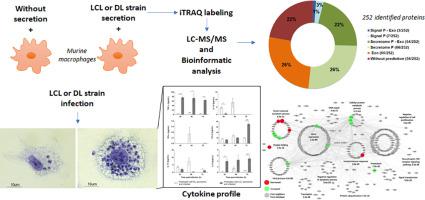Journal of Proteomics ( IF 3.3 ) Pub Date : 2020-12-10 , DOI: 10.1016/j.jprot.2020.104077 Andrés Rodríguez-Vega 1 , Monica Losada-Barragán 2 , Luiz Ricardo Berbert 3 , Camila Mesquita-Rodrigues 4 , Ana Cristina Souza Bombaça 5 , Rubem Menna-Barreto 5 , Priscila Aquino 6 , Paulo C Carvalho 7 , Gabriel Padrón 1 , Jose Batista de Jesus 8 , Patricia Cuervo 1

|
The role of Leishmania braziliensis in the development of different clinical forms of American Tegumentary Leishmaniasis (ATL) is unclear, but it has been suggested that molecules secreted/released by parasites could modulate the clinical outcome. Here, we analyzed the infection rate and cytokine profile of macrophages pretreated with the secretome of two L. braziliensis strains associated with polar clinical forms of ATL: one associated with localized self-healing cutaneous leishmaniasis (LCL) and other associated with the disseminated form (DL). Besides, we use an iTRAQ-based quantitative proteomics approach to compare the abundance of proteins secreted by those strains. In vitro infection demonstrated that pretreatment with secretome resulted in higher number of infected macrophages, as well as higher number of amastigotes per cell. Additionally, macrophages pretreated with LCL secretome exhibited a proinflammatory profile, whereas those pretreated with the DL one did not. These findings suggest that secretomes made macrophages more susceptible to infection and that molecules secreted by each strain modulate, differentially, the macrophages' cytokine profile. Indeed, proteomics analysis showed that the DL secretome is rich in molecules involved in macrophage deactivation, while is poor in proteins that activate proinflammatory pathways. Together, our results reveal new molecules that may contribute to the infection, persistence and dissemination of the parasite.
Significance
Leishmania braziliensis is associated to localized self-healing cutaneous lesions (LCL), disseminated leishmaniasis (DL), and mucocutaneous lesions (MCL). To understand the role of the parasite in those distinct clinical manifestations we evaluated infection rates and cytokine profiles of macrophages pre-treated with secretomes of two L. braziliensis strains associated with DL and LCL, and quantitatively compared these secretomes. The infection index of macrophages pretreated with the DL secretome was significantly higher than that exhibited by non-treated cells. Interestingly, whereas the LCL secretome stimulated a proinflammatory setting, favoring an effector cell response that would explain the proper resolution of the disease caused by this strain, the DL strain was not able to elicit such response or has mechanisms to prevent this activation. Indeed, DL secretome is rich in peptidases that may deactivate cell pathways crucial for parasite elimination, while is poor in proteins that could activate proinflammatory pathways, favoring parasite infection and persistence.
中文翻译:

定量分析巴西利什曼原虫(Viannia)菌株分泌的与美国皮肤性利什曼病的不同临床表现相关的蛋白质
巴西利什曼原虫在美国临床利什曼病(ATL)的不同临床形式发展中的作用尚不清楚,但已提出寄生虫分泌/释放的分子可调节临床结果。在这里,我们分析了用两个L的分泌组预处理的巨噬细胞的感染率和细胞因子谱。与ATL的极性临床形式有关的巴西菌株:一种与局部自我修复皮肤利什曼病(LCL)有关,另一种与传播形式(DL)有关。此外,我们使用基于iTRAQ的定量蛋白质组学方法来比较那些菌株分泌的蛋白质的丰度。体外感染表明,用分泌蛋白组进行预处理可导致感染的巨噬细胞数量增加,每个细胞的变形虫数量也增加。另外,用LCL分泌蛋白预处理的巨噬细胞表现出促炎性,而用DL预处理的巨噬细胞则没有。这些发现表明,分泌蛋白组使巨噬细胞更易于感染,并且每种菌株分泌的分子以不同方式调节巨噬细胞的细胞因子谱。确实,蛋白质组学分析表明DL分泌组富含参与巨噬细胞失活的分子,而缺乏激活促炎途径的蛋白质。总之,我们的结果揭示了可能有助于寄生虫感染,持久性和传播的新分子。
意义
巴西利什曼原虫与局部自我修复的皮肤病变(LCL),弥散性利什曼病(DL)和粘膜皮肤病变(MCL)相关。为了了解该寄生虫在那些不同的临床表现中的作用,我们评估了用两个巴西乳杆菌分泌蛋白预处理的巨噬细胞的感染率和细胞因子谱。DL和LCL相关菌株,并定量比较这些分泌组。用DL分泌组预处理的巨噬细胞的感染指数显着高于未处理的细胞。有趣的是,尽管LCL分泌组刺激了促炎性环境,有利于效应细胞反应,这可以解释由该菌株引起的疾病的适当解决方案,但DL菌株无法引发这种反应或具有阻止这种活化的机制。的确,DL分泌组富含肽酶,可以使对寄生虫消除至关重要的细胞途径失活,而DL蛋白质组的蛋白质可以激活促炎途径,从而有利于寄生虫感染和持久性。



























 京公网安备 11010802027423号
京公网安备 11010802027423号